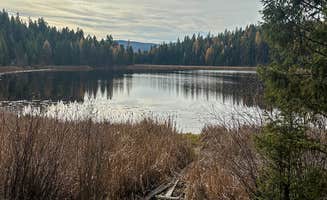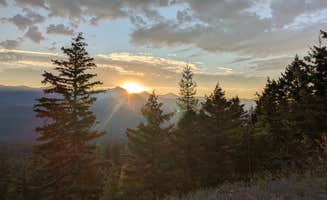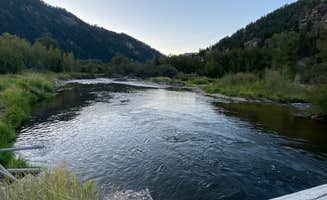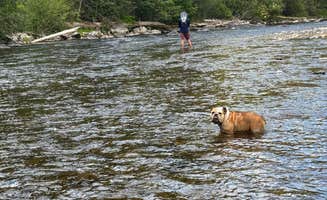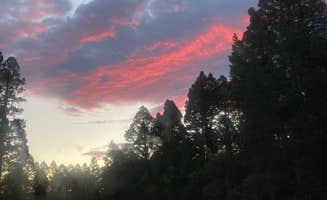Dispersed camping near Ovando, Montana extends throughout the Lolo and Helena-Lewis and Clark National Forests at elevations ranging from 4,000 to 8,000 feet. The area experiences significant seasonal weather variations, with summer temperatures averaging 75-85°F and winter lows frequently below freezing. Most dispersed sites remain snow-covered and inaccessible until late May through mid-October depending on elevation.
What to do
Explore ghost town history: The Garnet Ghost Town offers unique historical experiences for campers staying in surrounding areas. "Many states out west allow dispersed camping on select public lands owned by the Bureau of Land management. You need to pick up a map of exactly where you're allowed to camp," notes camper Harry H. Visitors can rent historic cabins that have been updated or simply tour the preserved mining town.
Backcountry fishing: High mountain lakes near dispersed sites provide excellent fishing opportunities with minimal competition. "Amazing fishing, great views. Short hikes to other high mountain lakes," reports K B. about Lucifer Lake, which requires a nonresident reservation conservation permit available through Montana Fish, Wildlife & Parks.
Wildlife observation: The alpine lakes and surrounding forests host diverse wildlife populations. Boulder Lake campers report "a pair of loons nesting at the lake" according to K B., who recommends watching for activity in early summer months when birds are most active.
What campers like
Remote mountain lake access: Lake Marshall offers primitive camping with premium lakeside positioning. "Only 1 site on the lake shore, 2-3 other sites scattered along the road in not as ideal but not that far. Great hiking just a little drive away along an old forest service road," shares BriAnne M.
Winter cabin options: Several historic structures are available for winter reservations when road access becomes limited. Amanda L. notes about Garnet Ghost Town: "During the winter two of the cabins (the larger of which is the old saloon) are available to rent through the forest service. Most of my recent trips have been during the winter months, where the town is only accessible by ski, snow shoe or feet."
Cell connectivity: Unlike many wilderness areas, some dispersed sites maintain limited communications access. "Spotty cell reception on shore of lake," mentions one camper about Pyramid Lake, while Ben H. reports about Blue Mountain Road: "I was able to get Verizon signal at my campsite. However driving up signal was spotty."
What you should know
Camping restrictions: Free camping near Ovando is subject to specific location limitations. Multiple campers note that Garnet Ghost Town prohibits camping within a half-mile radius of the town itself. "This location is not a campsite as it is within the 1/2 mile zone. It is marked with no camping sign," clarifies Susan S.
Road conditions: Blue Mountain Forest Rd 365 presents challenging driving conditions. "Road is absolutely clapped out going up for like ten miles. Wouldn't recommend a rv or trailer unless you don't mind washboards. I got a flat tire going up so be careful of sharp rocks," warns David B.
Permit requirements: Some backcountry locations require specific permits. Lucifer Lake requires a "nonresident reservation conservation permit" which can be obtained through the Montana Fish, Wildlife & Parks website before your trip.
Tips for camping with families
Choose lake-based sites: Lake Elsina offers drive-in access to undeveloped camping with natural features kids enjoy. BriAnne M. describes it as "Absolutely gorgeous undeveloped area" but warns families should "stand the hordes of mosquitos and constant trail of hikers coming through the area hiking to Lake Dinah."
Bug protection: Multiple campers mention significant mosquito populations at higher elevation sites, particularly in June and July. Pack adequate repellent, mosquito nets, and long-sleeved clothing for evening hours when insects are most active.
Consider hiking distances: When planning backcountry camping with children, assess trail difficulty carefully. K B. notes about Boulder Lake that the "trail that descends the steep grade down to the lake is not horse friendly, difficult for those who struggle with steep terrain."
Tips from RVers
Bridge clearance challenges: Rock Creek Dispersed Spot presents specific challenges for larger vehicles. "We struggled with the two narrow bridges with tight turns in our travel trailer and then there's a large flood way dip in the road that you can bottom out on," warns Reames C.
Heat management: Rock Creek sites provide minimal shade cover, creating comfort challenges. "Most everything is exposed to direct sunlight so it gets HOT in the summer. Our AC did not even budge the temps sometimes," notes one camper about summer conditions.
Dispersed site identification: Finding appropriate free camping requires careful navigation. Ahron B. advises: "The grey area is public land the white square at the end of the road is private property by the map legend. The dots show where dispersed camping is allowed for this spot."



